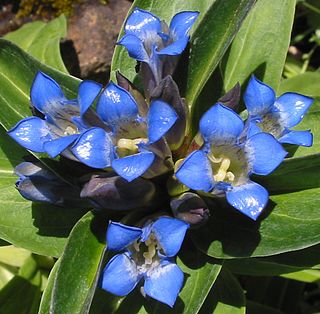
Gentianales is an order of flowering plant, included within the asterid clade of eudicots. It comprises more than 20,000 species in about 1,200 genera in 5 families. More than 80% of the species in this order belong to the family Rubiaceae.

Pachypodium is a genus of succulent spine-bearing trees and shrubs, native to Madagascar and Africa. It belongs to the family Apocynaceae.

The Asclepiadoideae are a subfamily of plants in the family Apocynaceae. Formerly, they were treated as a separate family under the name Asclepiadaceae, e.g. by APG II, and known as the milkweed family.
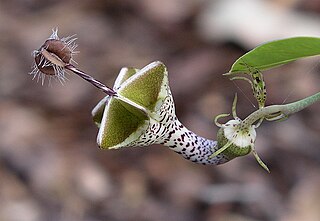
Ceropegia is a genus of plants within the family Apocynaceae, native to Africa, southern Asia, and Australia. It was named by Carl Linnaeus, who first described this genus in his Genera plantarum, which appeared in 1737. Linnaeus referred to the description and picture of a plant in the Horti Malabarici as the plant for which the genus was created. In 1753 he named this species as Ceropegia candelabrum. Linnaeus did not explain the etymology but later explanations stated that the name Ceropegia was from the Greek word keropegion κηροπηγɩον. This means candelabrum in Latin, which has a broader range than the modern word - "a candlestick, a branched candlestick, a chandelier, candelabrum, or also lamp-stand, light-stand, sometimes of exquisite workmanship".

Hoodia is a genus of flowering plants in the family Apocynaceae, under the subfamily Asclepiadoideae, native to Southern Africa.

Stapeliinae is a subtribe of flowering plants within the tribe Ceropegieae of the subfamily Asclepiadoideae of the family Apocynaceae. The subtribe comprises about 35 genera, including both the stem-succulent "stapeliads" and the horticulturally popular genera Brachystelma and Ceropegia. The largest number of genera are native to Africa, but a more limited number of genera are widespread in Arabia and Asia. Historically, a similarly circumscribed taxon was treated as a separate tribe, Stapelieae.

The genus Huernia consists of perennial, stem succulents from Eastern and Southern Africa and Arabia, first described as a genus in 1810.

Duvalia is a succulent plant genus in the subfamily Asclepiadoideae, in the family Apocynaceae (dogbane).
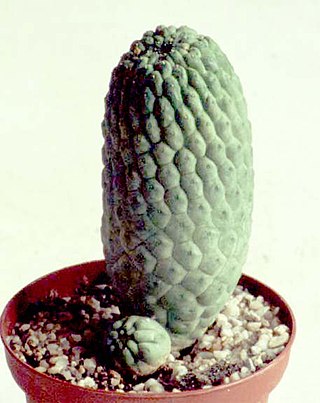
Larryleachia is a genus of stapeliad succulent flowering plants in the family Apocynaceae.

Lavrania is a monospecific genus of plants in family Apocynaceae. Its only species is Lavrania haagnerae, endemic to Namibia. Its natural habitat is rocky areas.
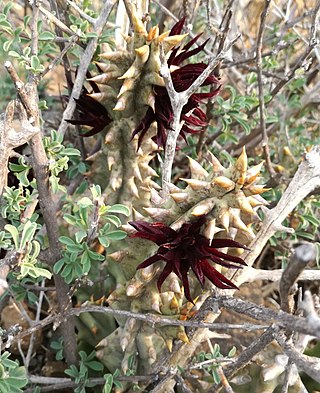
The genus Quaqua falls within the tribe of plants known collectively as stapeliads. All stapeliads, including Quaqua, are Old World stem succulents.

Edithcolea is a monotypic genus with a single species Edithcolea grandis. Once classified in the family Asclepiadaceae, it is now in the subfamily Asclepiadoideae of the dogbane family Apocynaceae. It is native to eastern Africa and to the Arabian Peninsula.

Stapelianthus is a genus of flowering plants in the family Apocynaceae, first described as a genus in 1933. The entire genus is endemic to Madagascar and is concentrated in the far south of the island.

Pseudolithos is a genus of succulent flowering plants of the family Apocynaceae, indigenous to arid areas of Somalia, Yemen and Oman.

Tavaresia is a genus of plants in the family Apocynaceae, first described as a genus in 1902. It is native to southern Africa.
- Tavaresia angolensisWelw. - Angola
- Tavaresia barklyi(Dyer) N.E.Br. - South Africa
- Tavaresia grandifloraBerger - South Africa
- Tavaresia meintjesiiR.A. Dyer - Limpopo

Echidnopsis is a genus of succulent, cactus-like plants in the family Apocynaceae, first described as a genus in 1871. They are native to eastern Africa and the Arabian Peninsula.

Piaranthus is a succulent plant genus in the subfamily Asclepiadoideae, in the family Apocynaceae.

Riocreuxia is a plant genus in the family Apocynaceae, and named in honour of the botanical illustrator Alfred Riocreux (1820-1912). It was first described as a genus in 1844 and is native to Africa.
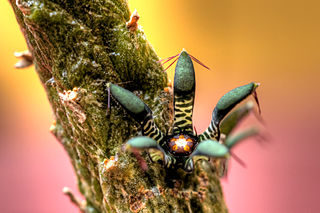
Rhytidocaulon is a plant genus in the family Apocynaceae, first described in 1962. It is native to northeastern Africa and the Arabian Peninsula

Duvalia elegans is a small succulent plant species, in the family Apocynaceae. It is the type species of the genus Duvalia, and it is endemic to the Western Cape Province, South Africa.



















